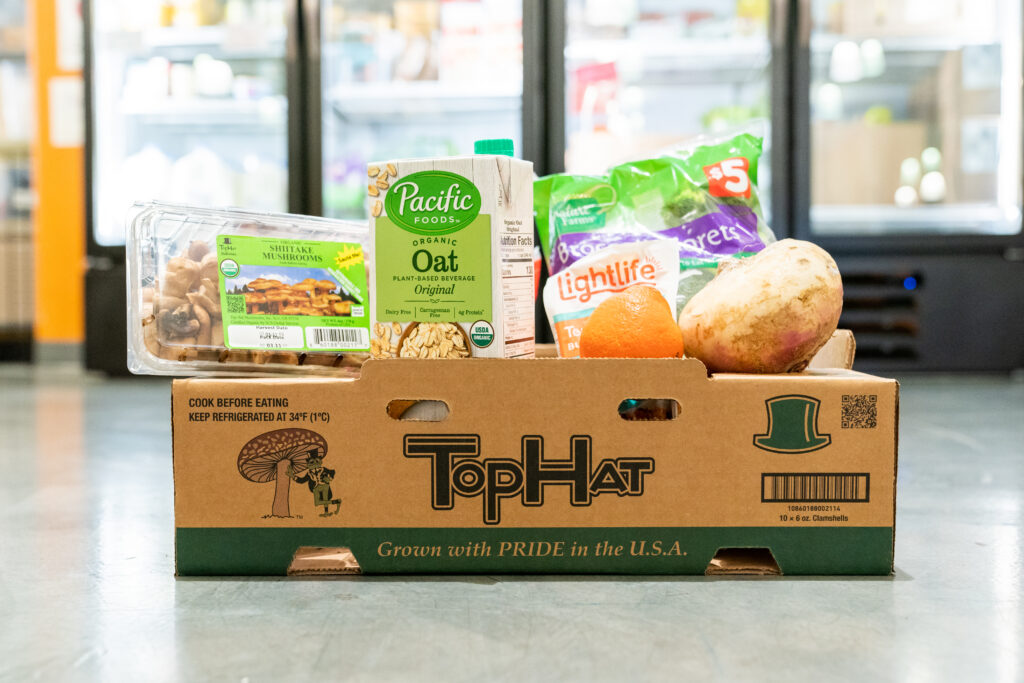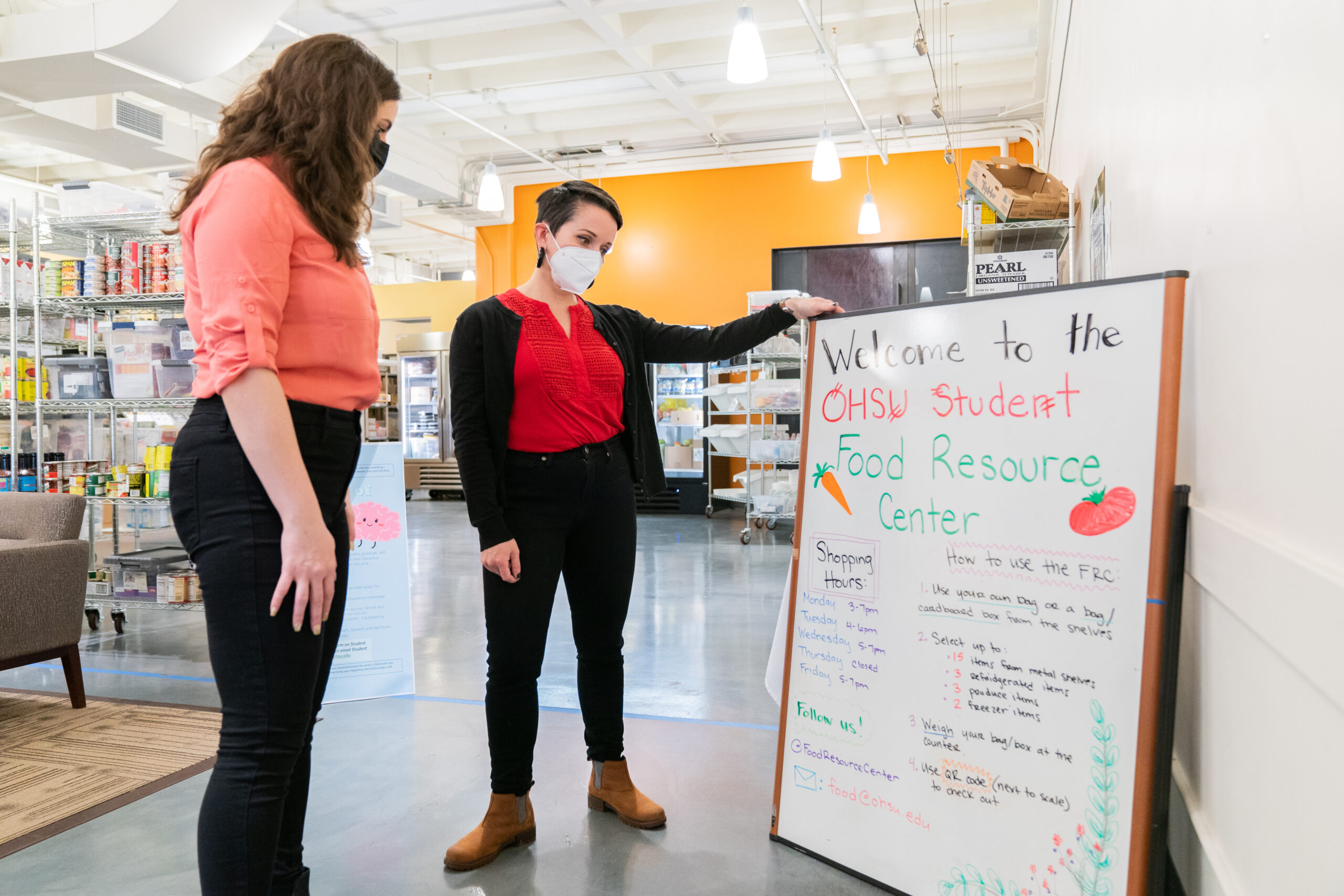For many of us, the phrase “starving college student” triggers memories of cheap pizza and instant ramen. But the starving student stereotype is no joke: hunger is growing on college campuses, and OHSU is no exception. In fact, student surveys revealed that 1 in 4 of our health professional students face food insecurity—and while that’s lower than the national average of 39%, even one hungry student is one too many.
Now thanks to the efforts of student leaders and committed faculty and staff, what started as a grassroots grocery box program has grown into the OHSU Food Resource Center (FRC)—a welcoming, on-campus resource dedicated to nourishing the next generation of healers, caregivers, and innovators.
Here’s how the FRC came to be—and how you can help it expand its mission.
The many factors of food insecurity
Rising tuition, transportation and housing costs, lack of time, or limited access to convenient and healthy food all play a role in food insecurity on college campuses. Students may find themselves skipping meals to pay for textbooks or cover tuition, opting to go hungry so they can keep their education moving forward.
“When you’re in clinic all day long or working shifts over the weekend, it can be extremely difficult to shop for and prepare healthy food,” explained Gina Calco, a MD/PhD student who serves on OHSU’s Food Insecurity Task Force. “Our graduate medical students told us that they were going to events just to get free food, or that sometimes they had trouble studying because they were so hungry.”
A grassroots effort
In 2019, the Task Force began laying the groundwork for an on-campus food pantry. But a few months into the planning stages, covid hit, putting food-insecure students in an even more vulnerable position.
Determined to keep their fellow classmates fed, Gina teamed up with Task Force member Maddie Egan to run a grassroots grocery box distribution program out of their homes. “We got a $500 grant from the Student Health and Wellness Center, went to Freddie’s, and bought a bunch of groceries,” Gina said. “Students let us know what they wanted, and we’d leave the boxes out on our porch for them to pick up.”
The FRC opens its doors
Meanwhile, the Task Force shifted their food pantry plans into high gear, partnering with the Oregon Food Bank and local businesses like Reeser’s and Bob’s Red Mill to help them stock the shelves. They also bought six CSA shares from a local farmer to provide a steady supply of fresh produce that was cultivated, harvested, and prepared for delivery by OHSU dietetic interns completing rotations on the farm. And to ensure that the entire student body was represented, they spoke with students from culturally diverse backgrounds to learn what would be in their cupboards at home.
“We wanted to make it a welcoming, culturally affirming place,” explained Dr. Diane Stadler, a Professor of Medicine and Director of the Graduate Programs in Human Nutrition at OHSU. “So we showcased certain food traditions or holidays that people from different cultures would celebrate to underscore that the Food Resource Center is a place for everyone.”
The OHSU Food Resource Center, warmly referred to as the FRC, officially opened in December of 2019. As word of mouth grew, so did the number of students served. “We started small, but now we welcome at least 100 students a week,” Stadler said.
In addition to browsing the shelves, students can also request food online and pick up their order at the FRC. If a student can’t make it to campus, a volunteer will pick up their order and deliver it to their home. And in the spirit of inclusivity, students are not required to show proof of financial need or food insecurity to take advantage of the program. “That was really important to us,” Stadler explained. “The FRC is intentionally open to all students without question, and all food is available at no charge.”
“I feel supported by my school”
Sofia Vignolo is a second-year MD/PhD student from Buenos Aries, Argentina. Her schedule—and her budget—leave little room to shop for fresh, healthy food, so the FRC has become a weekly go-to for her. It also gives her the chance to try new foods she’d never think of buying otherwise.
“That place is magical!” she smiled. “They have so many diverse, unique ingredients—I ate bamboo shoots for the first time in my life and used them to make spring rolls. Besides all the fresh produce, they have fish sauce, masa, mole, you name it. The amount of good, quality food that’s available to us is truly amazing.”
Sofia is such a fan of the FRC that she started the unofficial Food Resource Center Instagram page, where she collaborates with FRC members to post featured items, recipes, and inspiring pics of meals created with ingredients from the FRC. Sofia figures it’s the least she can do to give back to the place that’s done so much to keep her fed.
“The FRC has inspired me to eat healthier, allows me to focus on my studies and definitely helps with finances,” she said. “But for me, the biggest thing is that it makes me feel supported by my school.”
First-year Human Nutrition student Megan McNairn is also quick to sing the FRC’s praises. As a future dietitian, she’s already using her first-hand experience with the FRC to educate the community about proper nutrition. “For one of my rotations, I worked at the food pantry for Outside In,” she explained. “Youth clients would come in, hold up some produce and say, ‘Is this good? What can I do with it?’ Because I had gotten the exact same produce at the FRC, I could say ‘Yes! It’s really good and here’s what I made with it.’ Being able to have those kinds of conversations with my patients is going to be really relevant down the line.”

There’s more to be done—and less to do it with
The FRC is currently seeking to expand its services from the upper campus to the South Waterfront campus and beyond. “We’re starting to reach out to some of OHSU’s more rural campuses, where students don’t always have easy access to the grocery store,” Stadler said.
And students aren’t the only members of the OHSU community facing food insecurity. The Task Force is also looking for ways to support the OHSU workforce and patients facing a long hospital stay.
“As patients and their families leave the hospital, we want to make sure that they can go home with a box of food and not have to worry how long it’s been since they’ve been to the grocery store,” said Stadler. “Hopefully we can make all that happen in the not-too-distant future.”
With the cost of food rising and only half of their food provided by the Oregon Food Bank or local partners, the FRC is relying on the generosity of donors now more than ever.
“Everything we want to do takes resources, and the funding we receive isn’t keeping up with inflation,” said Stadler. “That’s why philanthropic support is so critical to our mission. When you give to the FRC, you’re helping to feed our future healthcare professionals.”
Donations to the OHSU Food Resource Center are eligible for the Sprint for OHSU Students matching program! Your gift will be matched $1 for every $2 while funds last.

